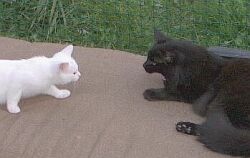 |
| Larry, Day 1 |
Heading into the clinic after lunch Friday, a strange baby cry greeted me by the back door. A tiny, bedraggled kitten ventured toward me. Cautiously I picked him up. Immediately his little velcro claws stuck to my shirt and a disproportionately loud purr began. I was hooked.
Has this happened to you yet? So many of my feline patients began their lives as strays, the arrival of little Larry seems like a perfect time to discuss how to bring a stray into
your home.
1. When interacting with a stray cat (or any unknown animal), use caution! He may not be used to being handled and could bite or scratch out of fear. Rabies
does affect cats, and many do not exhibit the classic Cujo signs of rabidity.
2. If the stray is amenable to being handled, make a veterinary appointment for him as soon as possible. Until then, keep him quarantined from your other pets to limit transmission of contagious diseases and parasites. Best not to let your children play with him either until he passes veterinary inspection.
3. Fleas are very common on strays. Poor Larry was covered in them. Where the black pellets of "flea dirt" (i.e., flea poop which is digested blood) had gotten wet, his white patches of fur were stained red!
I DO NOT RECOMMEND GIVING A FLEA BATH. The chemicals in flea shampoos can be toxic--especially in cats and debilitated animals (which most strays are). Call your veterinarian for alternatives to flea baths.
4. After handling your new stray or his litter box, wash your hands thoroughly. If you have other cats at home, you may want to change your clothes after handling the stray to avoid transferring contagions.
At your stray's first veterinary check-up here are some things to expect:
1. The stray should be scanned for a
microchip. Some strays are actually lost pets. The rightful owners will be grateful to know he has been found safe and sound!
2. Especially if you have other cats at home, a Feline Leukemia Virus (FeLV) and Feline Immunodeficiency Virus (FIV) test should be done. This is a simple blood test that can show if the stray has these viruses. Inadvertant introduction of theses viruses into your existing cat household can be devastating.Your veterinarian can explain the details of the diseases and testing.
3. The stray should be dewormed according to your veterinarian's protocol. Aside from tapeworms, most intestinal parasites are
not readily obvious in the stool. Assume all strays have worms. After all, if the cat was eating rodents to survive he surely has worms!
4. Your veterinarian can treat the fleas, ticks, ear mites, lice or other external parasite(s) found. Be sure to ask if you need to clean where the kitty has been hanging out at home. Many parasites can only be eliminated after multiple treatments plus environmental decontamination.
 |
| Larry, Day 3 |
5. Many strays have upper respiratory infections stemming from common feline viruses. Your veterinarian may recommend vaccinating against feline distemper to help prevent complications from these infections. Depending on the stray's estimated age, your veterinarian may recommend the rabies vaccine as well.
6. Once your new kitty has been determined to be in good health, it is time to consider sterilization surgery. It is easy to tell if an adule male cat has been neutered, but much harder to tell if an adult female has been spayed. Spaying and neutering not only eliminates unwanted litters, but reduces unpleasant behaviors and future health problems.
Now that your stray kitty has a clean bill of health, you can settle down to enjoy the rare pleasures that come from feline companionship! You have been chosen by this kitty to provide the care necessary for his comfortable life. If your stray is like most I've met (including Larry), he is overflowing with affection and devotion.
 The witching hour approaches on the eve of Halloween. I spent a good deal of my day helping my kids prepare for Trick-or-Treating.
The witching hour approaches on the eve of Halloween. I spent a good deal of my day helping my kids prepare for Trick-or-Treating. Dressing up dogs has become a real sport. Dogs have been wearing sweaters for ages and for good reason. Very small dogs and those not designed for Wisconsin winters have a hard time maintaining their body temperature. A husky may finally be at his ease on a drify December day, but a Boston Terrier may refuse to even go out to use the bathroom!
Dressing up dogs has become a real sport. Dogs have been wearing sweaters for ages and for good reason. Very small dogs and those not designed for Wisconsin winters have a hard time maintaining their body temperature. A husky may finally be at his ease on a drify December day, but a Boston Terrier may refuse to even go out to use the bathroom!  Animal clothing has gone far beyond practical nowadays. Our pets are budding fashion models it seems. I've seen raincoats for labradors and tutus for teacup poodles. Some creative pet owners fashion their own designer dog digs out of newborn baby clothes.
Animal clothing has gone far beyond practical nowadays. Our pets are budding fashion models it seems. I've seen raincoats for labradors and tutus for teacup poodles. Some creative pet owners fashion their own designer dog digs out of newborn baby clothes. 












